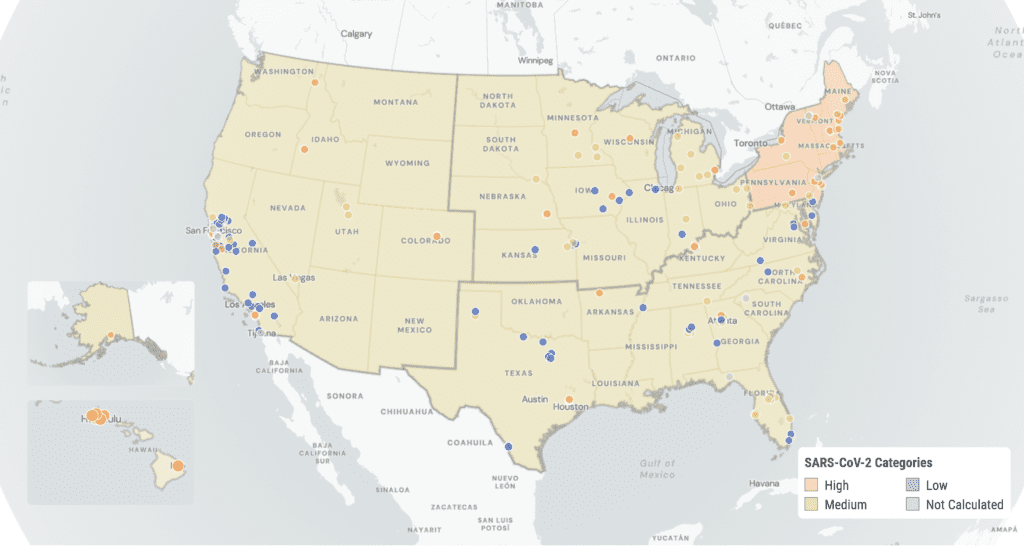The Weather
While not in the US, an article from CBC News in Canada offers a look into the upcoming respiratory illness season. Data from Internal Alberta Health Services shows that patients hospitalized with COVID passed 900 and “roughly doubled” in a month. Accurate data are hard to find, however, as the provincial government changed how COVID statistics are reported. Cameron Westhead, second vice-president with United Nurses of Alberta, commented, “This government likes to talk about personal responsibility and making decisions that are best for yourself and your family. But we don’t have the data to make those kinds of decisions.”
In addition, an outbreak in the community has the potential to overwhelm hospital systems again. Isolation requirements, PPE needs, and healthcare worker burnout are all major concerns with COVID patients. Rather than stripping healthcare of the precautions we need to control the ongoing pandemic, we must advocate for more support for healthcare workers, masks in healthcare, and acknowledgment of the severity of COVID infections.
Wastewater
We continue to wait for Verily, the organization taking over the National Wastewater Surveillance System (NWSS) contract from Biobot, to provide a readable Nationwide representation of the current wastewater levels.
According to WastewaterSCAN, COVID wastewater concentration is medium nationally, apart from high levels in the Northeast. As of October 16, 2023, the national average of wastewater levels is 216.9 PMMoV Normalized. Regionally, the Midwest is 317.0 PMMoV Normalized, the Northeast is 589.82 PMMoV Normalized, the South is 152.3 PMMoV Normalized, and the West is 164.7 PMMoV Normalized. We emphasize that Wastewater SCAN has fewer wastewater sites represented as compared to Biobot. Combined with some other caveats, including the difficulty of interpreting their plots, we remain skeptical of Wastewater SCAN’s data.


The above graphic shows the overall trend for the United States. The y-axis is a scale for the quantity of nucleic acids, PMMoV Normalized (x1 million). While concentrations have been trending downward–with a possible recent uptick–we urge the importance of layers of protection. As the Northern Hemisphere enters winter and many folks celebrate holidays, please protect yourself and others with masking, distancing, clean air, vaccines, and other layers of protection. For more on layers of protection, refer to this writeup on PeoplesCDC.org.
Vaccines
NPR reports that parents are finding it difficult to find pediatric doses of the new COVID vaccines for their children. The CDC reports that pediatric doses are available, but several factors are limiting their spread. Faulty websites or outdated information from public and private organizations, shipping delays or errors in the number of doses shipped, and issues with public and private insurance all contribute to a lackadaisical approach to public health. Parents are frustrated at the situation and scared for their kids, especially as we enter flu season.
We hope that if you haven’t been able to receive an updated 2023-2024 COVID vaccine, you are able to access a dose soon. If you have questions about insurance coverage, visit the KFF information page here. For children covered under state insurance, see information about the Vaccines for Children program. Uninsured adults may receive assistance through the Bridge Access Program. Please note not every pharmacy or clinic participates in this important program.
Long COVID
An article from the University of Minnesota’s Center for Infectious Disease Research and Policy (CIDRAP) argues that Long COVID studies in children are lacking. Estimates of prevalence of Long COVID in children range from 1% to 70%. Children may have different experiences with Long COVID from adults, as well as having limited vocabulary to describe their symptoms. Poor study design also contributes to artificially low numbers. Hannah Davis, cofounder of the Patient-Led Research Collaborative, suggests that further studies could use a prepandemic cohort or electronic health record data to serve as controls rather than a cohort defined by negative PCR tests, which could contain false negatives. Additionally, more longitudinal studies are needed. The article highlights a huge range of uncertainty reflecting a lack of research. Children with Long COVID deserve recognition, care, and support.
Take Action
Reminder to either submit a written comment or register to give an oral comment to the CDC’s HICPAC meeting on November 2-3, 2023. National Nurses United provided some guidance on talking points one can use during the oral comments. You can submit written comments to HICPAC@CDC.GOV starting November 1, 2023, with the deadline at 11:59 pm on November 6, 2023. To request time for an oral comment during the webcast, submit your request to the oral comment submission form no later than 11:59 p.m., EST, October 23, 2023.
As the CDC is poised to weaken protections for patients and healthcare workers, please sign on with National Nurses United and demand the CDC be transparent. At the link, you can fill out a form to send an email to CDC/HICPAC leaders that emphasizes the need to post the updated guidelines in full for public review, make meetings and comments open to the public, and use a science-based approach to aerosol transmission.
Notes: 1) The numbers in this report were current as of 10/20/2023. 2) Changes in testing access as well as data reporting have led many federal data sources to become less reliable. 3) Wastewater data are being sourced from WastewaterSCAN and no longer from BioBot due to the end of the contract with the CDC. 3) Check out the links throughout & see our website for more! https://bej.gbh.mybluehost.me